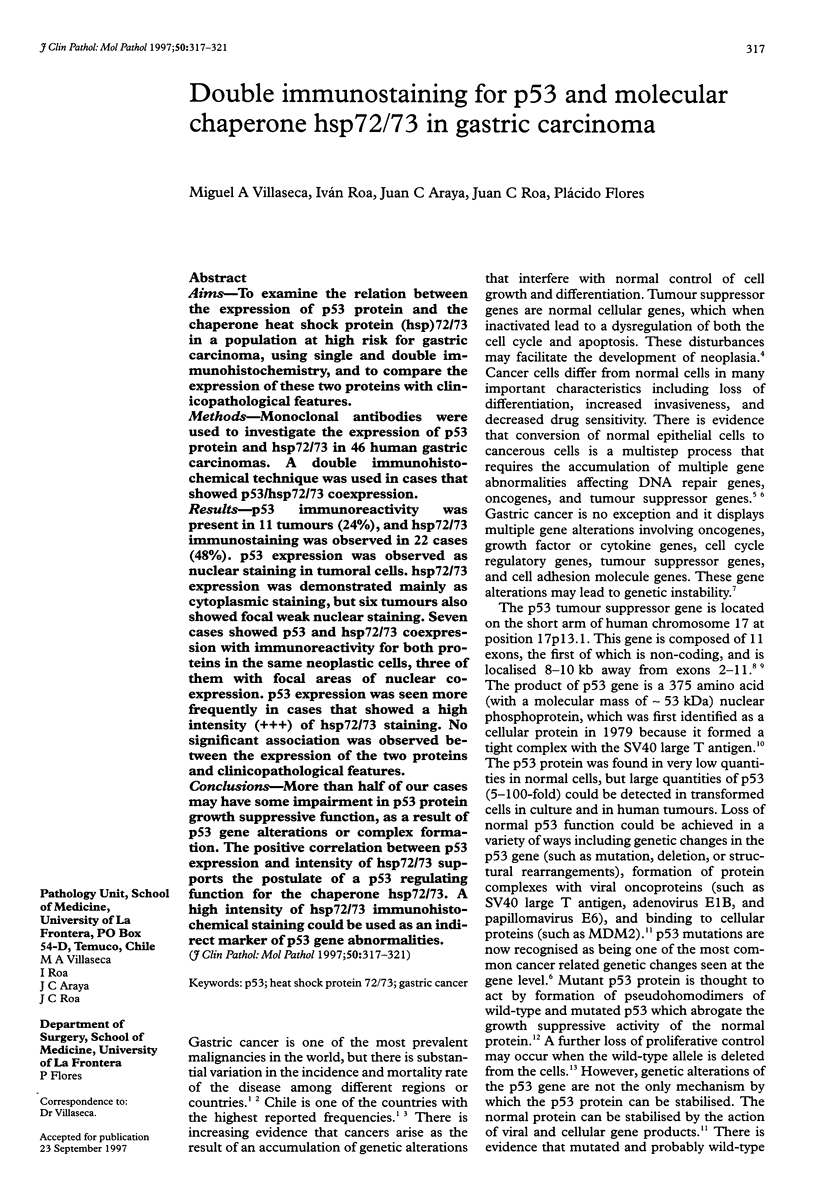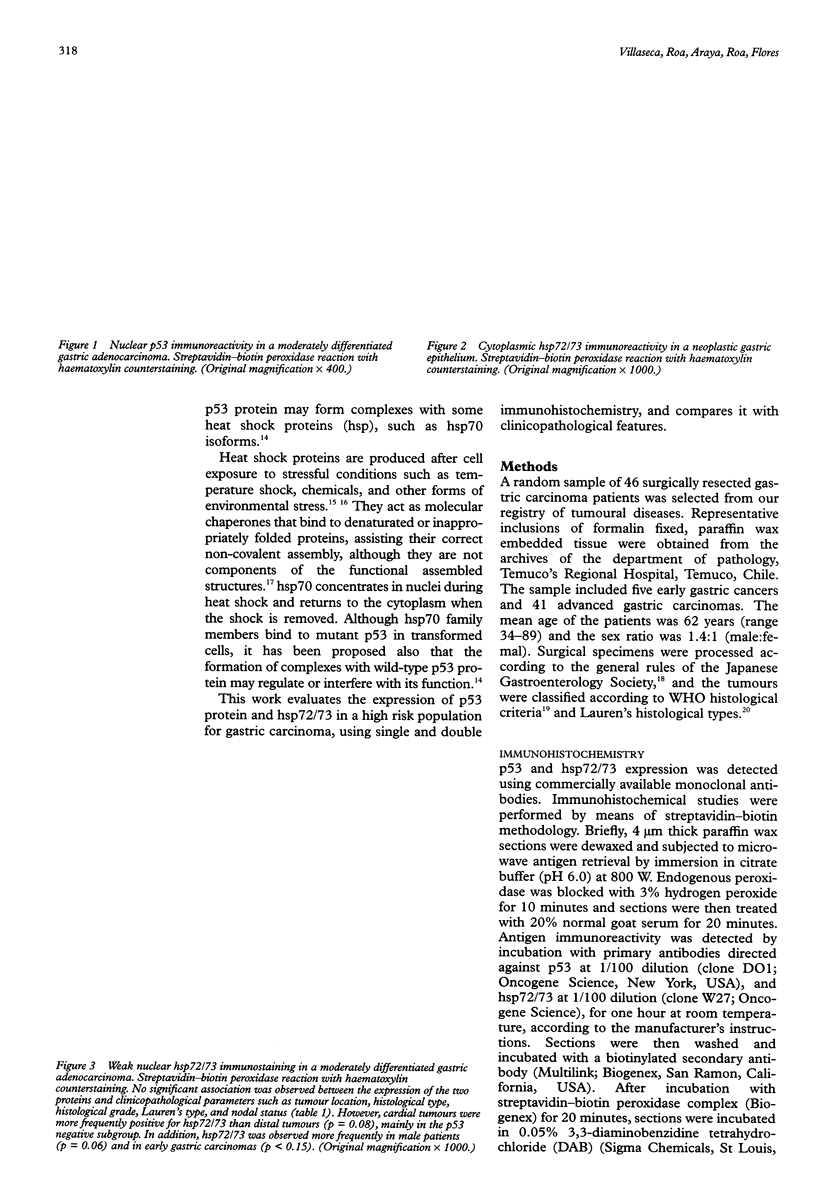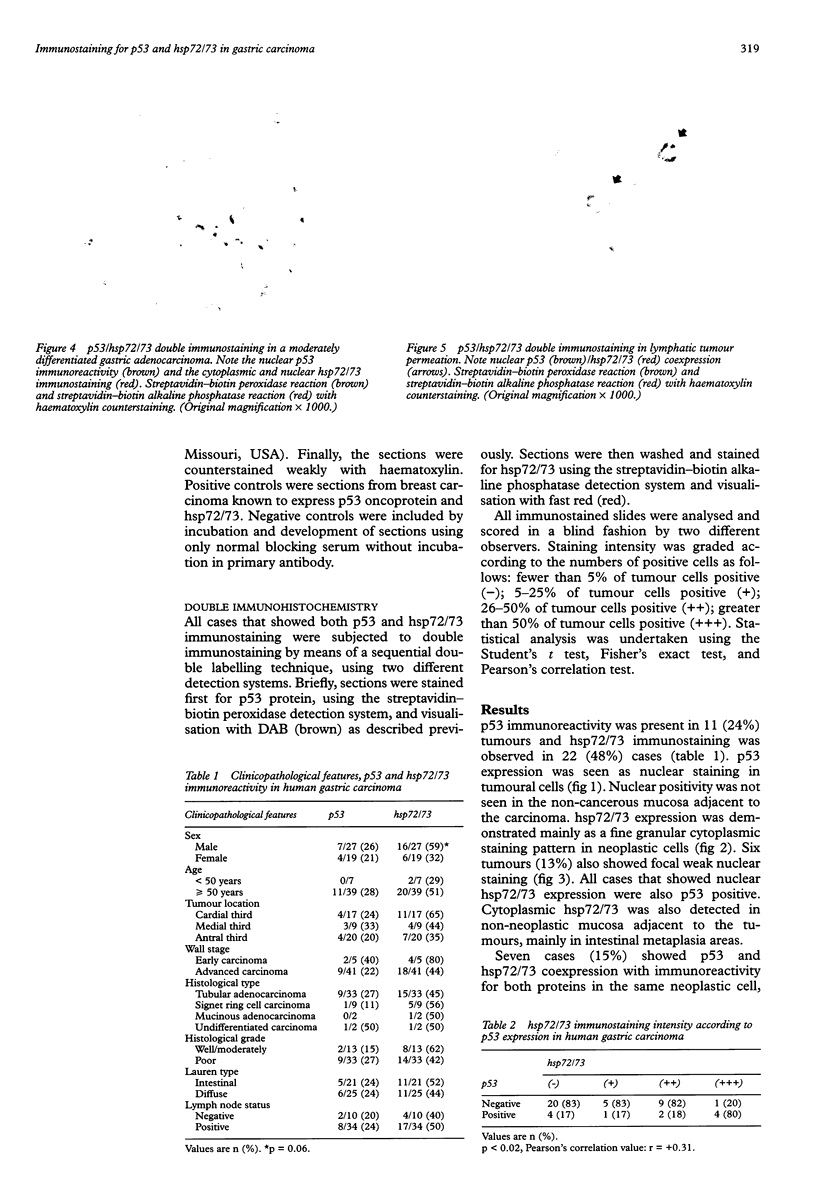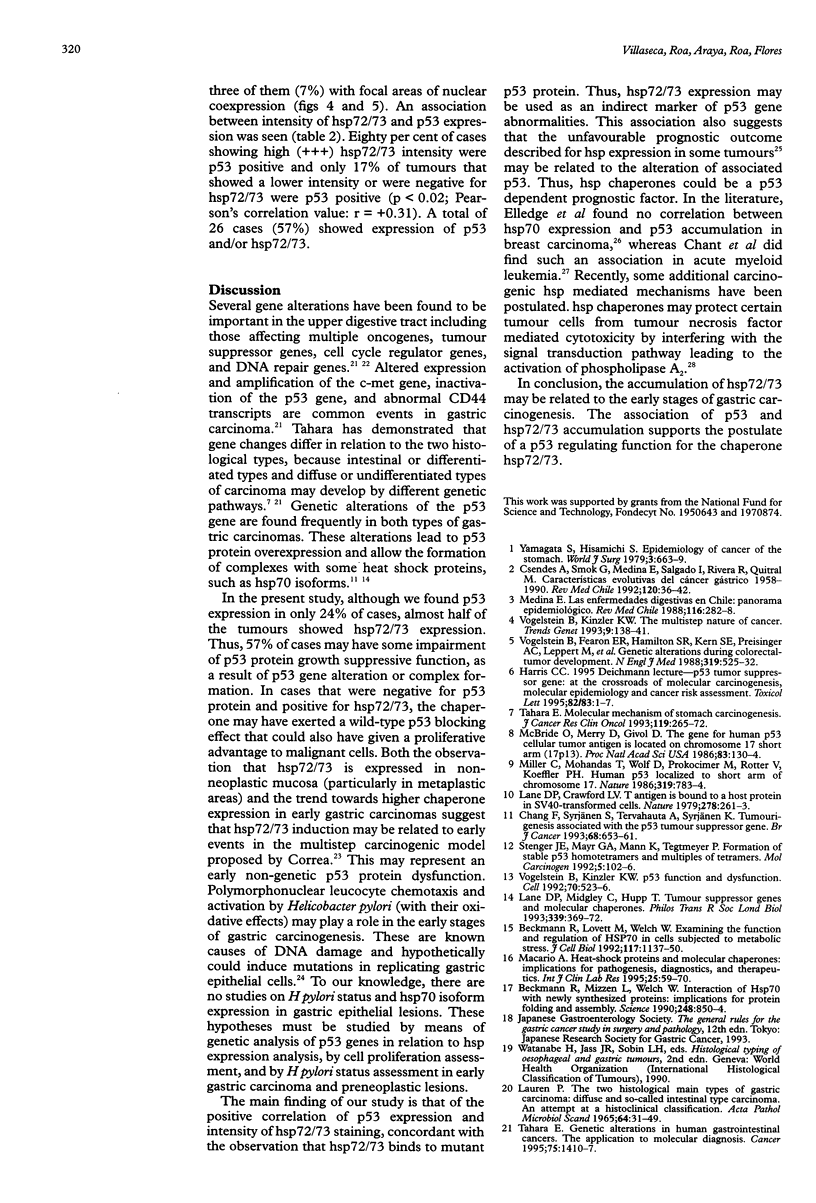Abstract
AIMS: To examine the relation between the expression of p53 protein and the chaperone heat shock protein (hsp)72/73 in a population at high risk for gastric carcinoma, using single and double immunohistochemistry, and to compare the expression of these two proteins with clinicopathological features. METHODS: Monoclonal antibodies were used to investigate the expression of p53 protein and hsp72/73 in 46 human gastric carcinomas. A double immunohistochemical technique was used in cases that showed p53/hsp72/73 coexpression. RESULTS: p53 immunoreactivity was present in 11 tumours (24%), and hsp72/73 immunostaining was observed in 22 cases (48%). p53 expression was observed as nuclear staining in tumoral cells. hsp72/73 expression was demonstrated mainly as cytoplasmic staining, but six tumours also showed focal weak nuclear staining. Seven cases showed p53 and hsp72/73 coexpression with immunoreactivity for both proteins in the same neoplastic cells, three of them with focal areas of nuclear coexpression. p53 expression was seen more frequently in cases that showed a high intensity (+ + +) of hsp72/73 staining. No significant association was observed between the expression of the two proteins and clinicopathological features. CONCLUSIONS: More than half of our cases may have some impairment in p53 protein growth suppressive function, as a result of p53 gene alterations or complex formation. The positive correlation between p53 expression and intensity of hsp72/73 supports the postulate of a p53 regulating function for the chaperone hsp72/73. A high intensity of hsp72/73 immunohistochemical staining could be used as an indirect marker of p53 gene abnormalities.
Full text
PDF




Images in this article
Selected References
These references are in PubMed. This may not be the complete list of references from this article.
- Beckmann R. P., Mizzen L. E., Welch W. J. Interaction of Hsp 70 with newly synthesized proteins: implications for protein folding and assembly. Science. 1990 May 18;248(4957):850–854. doi: 10.1126/science.2188360. [DOI] [PubMed] [Google Scholar]
- Chang F., Syrjänen S., Tervahauta A., Syrjänen K. Tumourigenesis associated with the p53 tumour suppressor gene. Br J Cancer. 1993 Oct;68(4):653–661. doi: 10.1038/bjc.1993.404. [DOI] [PMC free article] [PubMed] [Google Scholar]
- Chant I. D., Rose P. E., Morris A. G. Susceptibility of AML cells to in vitro apoptosis correlates with heat shock protein 70 (hsp 70) expression. Br J Haematol. 1996 Jun;93(4):898–902. doi: 10.1046/j.1365-2141.1996.d01-1737.x. [DOI] [PubMed] [Google Scholar]
- Ciocca D. R., Clark G. M., Tandon A. K., Fuqua S. A., Welch W. J., McGuire W. L. Heat shock protein hsp70 in patients with axillary lymph node-negative breast cancer: prognostic implications. J Natl Cancer Inst. 1993 Apr 7;85(7):570–574. doi: 10.1093/jnci/85.7.570. [DOI] [PubMed] [Google Scholar]
- Correa P. A human model of gastric carcinogenesis. Cancer Res. 1988 Jul 1;48(13):3554–3560. [PubMed] [Google Scholar]
- Correa P. Is gastric carcinoma an infectious disease? N Engl J Med. 1991 Oct 17;325(16):1170–1171. doi: 10.1056/NEJM199110173251611. [DOI] [PubMed] [Google Scholar]
- Csendes A., Smok G., Medina E., Salgado I., Rivera R., Quitral M. Características evolutivas del cáncer gástrico 1958-1990. Rev Med Chil. 1992 Jan;120(1):36–42. [PubMed] [Google Scholar]
- Elledge R. M., Clark G. M., Fuqua S. A., Yu Y. Y., Allred D. C. p53 protein accumulation detected by five different antibodies: relationship to prognosis and heat shock protein 70 in breast cancer. Cancer Res. 1994 Jul 15;54(14):3752–3757. [PubMed] [Google Scholar]
- Harris C. C. 1995 Deichmann Lecture--p53 tumor suppressor gene: at the crossroads of molecular carcinogenesis, molecular epidemiology and cancer risk assessment. Toxicol Lett. 1995 Dec;82-83:1–7. doi: 10.1016/0378-4274(95)03643-1. [DOI] [PubMed] [Google Scholar]
- Jättelä M. Overexpression of major heat shock protein hsp70 inhibits tumor necrosis factor-induced activation of phospholipase A2. J Immunol. 1993 Oct 15;151(8):4286–4294. [PubMed] [Google Scholar]
- LAUREN P. THE TWO HISTOLOGICAL MAIN TYPES OF GASTRIC CARCINOMA: DIFFUSE AND SO-CALLED INTESTINAL-TYPE CARCINOMA. AN ATTEMPT AT A HISTO-CLINICAL CLASSIFICATION. Acta Pathol Microbiol Scand. 1965;64:31–49. doi: 10.1111/apm.1965.64.1.31. [DOI] [PubMed] [Google Scholar]
- Lane D. P., Crawford L. V. T antigen is bound to a host protein in SV40-transformed cells. Nature. 1979 Mar 15;278(5701):261–263. doi: 10.1038/278261a0. [DOI] [PubMed] [Google Scholar]
- Lane D. P., Midgley C., Hupp T. Tumour suppressor genes and molecular chaperones. Philos Trans R Soc Lond B Biol Sci. 1993 Mar 29;339(1289):369–373. doi: 10.1098/rstb.1993.0036. [DOI] [PubMed] [Google Scholar]
- Macario A. J. Heat-shock proteins and molecular chaperones: implications for pathogenesis, diagnostics, and therapeutics. Int J Clin Lab Res. 1995;25(2):59–70. doi: 10.1007/BF02592359. [DOI] [PubMed] [Google Scholar]
- McBride O. W., Merry D., Givol D. The gene for human p53 cellular tumor antigen is located on chromosome 17 short arm (17p13). Proc Natl Acad Sci U S A. 1986 Jan;83(1):130–134. doi: 10.1073/pnas.83.1.130. [DOI] [PMC free article] [PubMed] [Google Scholar]
- Medina E. Las enfermedades digestivas en Chile: panorama epidemiológico. Rev Med Chil. 1988 Mar;116(3):282–288. [PubMed] [Google Scholar]
- Miller C., Mohandas T., Wolf D., Prokocimer M., Rotter V., Koeffler H. P. Human p53 gene localized to short arm of chromosome 17. 1986 Feb 27-Mar 5Nature. 319(6056):783–784. doi: 10.1038/319783a0. [DOI] [PubMed] [Google Scholar]
- Stenger J. E., Mayr G. A., Mann K., Tegtmeyer P. Formation of stable p53 homotetramers and multiples of tetramers. Mol Carcinog. 1992;5(2):102–106. doi: 10.1002/mc.2940050204. [DOI] [PubMed] [Google Scholar]
- Tahara E. Genetic alterations in human gastrointestinal cancers. The application to molecular diagnosis. Cancer. 1995 Mar 15;75(6 Suppl):1410–1417. doi: 10.1002/1097-0142(19950315)75:6+<1410::aid-cncr2820751504>3.0.co;2-o. [DOI] [PubMed] [Google Scholar]
- Tahara E. Molecular mechanism of stomach carcinogenesis. J Cancer Res Clin Oncol. 1993;119(5):265–272. doi: 10.1007/BF01212724. [DOI] [PubMed] [Google Scholar]
- Vogelstein B., Fearon E. R., Hamilton S. R., Kern S. E., Preisinger A. C., Leppert M., Nakamura Y., White R., Smits A. M., Bos J. L. Genetic alterations during colorectal-tumor development. N Engl J Med. 1988 Sep 1;319(9):525–532. doi: 10.1056/NEJM198809013190901. [DOI] [PubMed] [Google Scholar]
- Vogelstein B., Kinzler K. W. The multistep nature of cancer. Trends Genet. 1993 Apr;9(4):138–141. doi: 10.1016/0168-9525(93)90209-z. [DOI] [PubMed] [Google Scholar]
- Vogelstein B., Kinzler K. W. p53 function and dysfunction. Cell. 1992 Aug 21;70(4):523–526. doi: 10.1016/0092-8674(92)90421-8. [DOI] [PubMed] [Google Scholar]
- Wright P. A., Quirke P., Attanoos R., Williams G. T. Molecular pathology of gastric carcinoma: progress and prospects. Hum Pathol. 1992 Aug;23(8):848–859. doi: 10.1016/0046-8177(92)90394-i. [DOI] [PubMed] [Google Scholar]
- Yamagata S., Hisamichi S. Epidemiology of cancer of the stomach. World J Surg. 1979 Nov;3(6):663–669. doi: 10.1007/BF01654784. [DOI] [PubMed] [Google Scholar]







